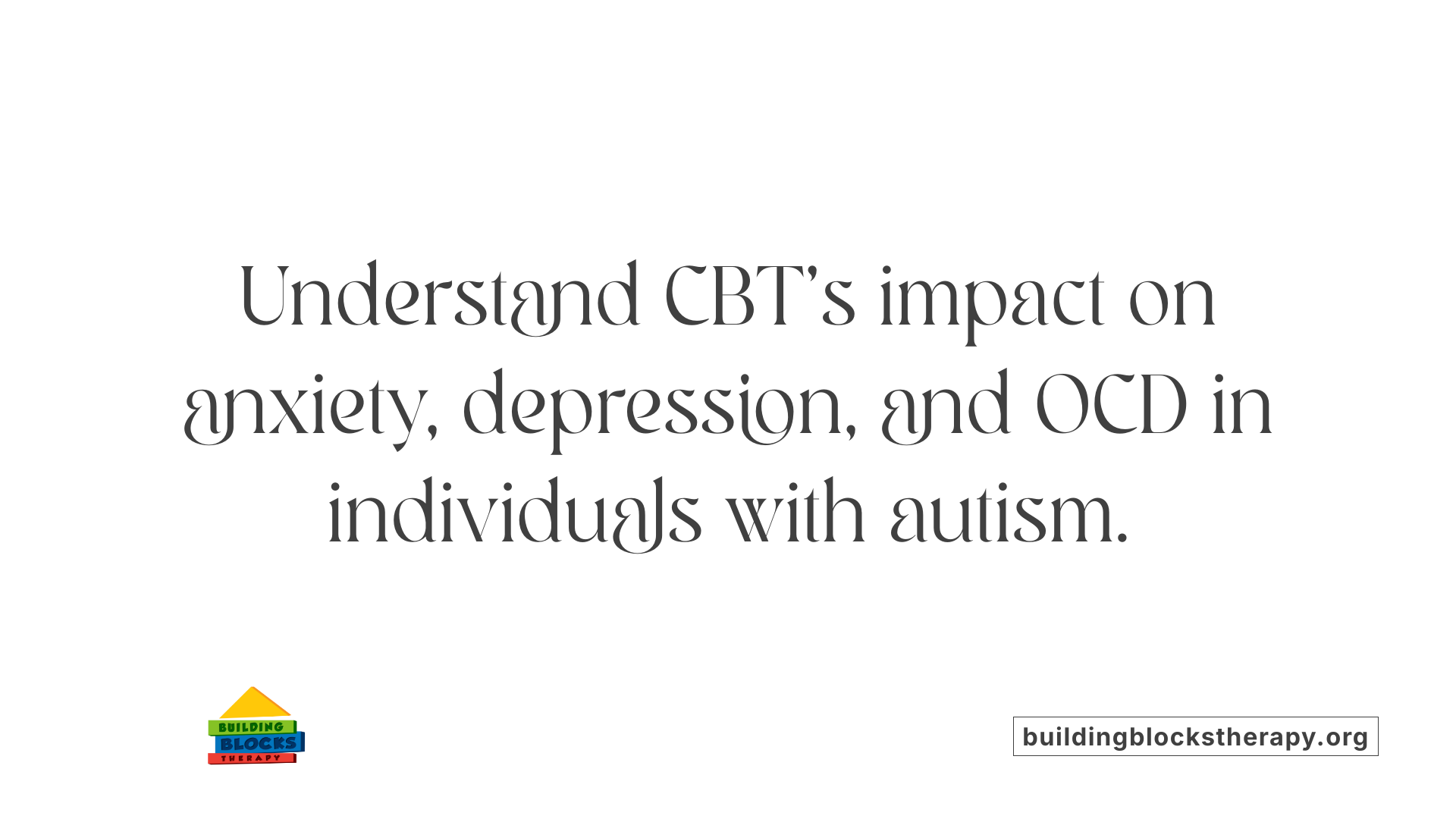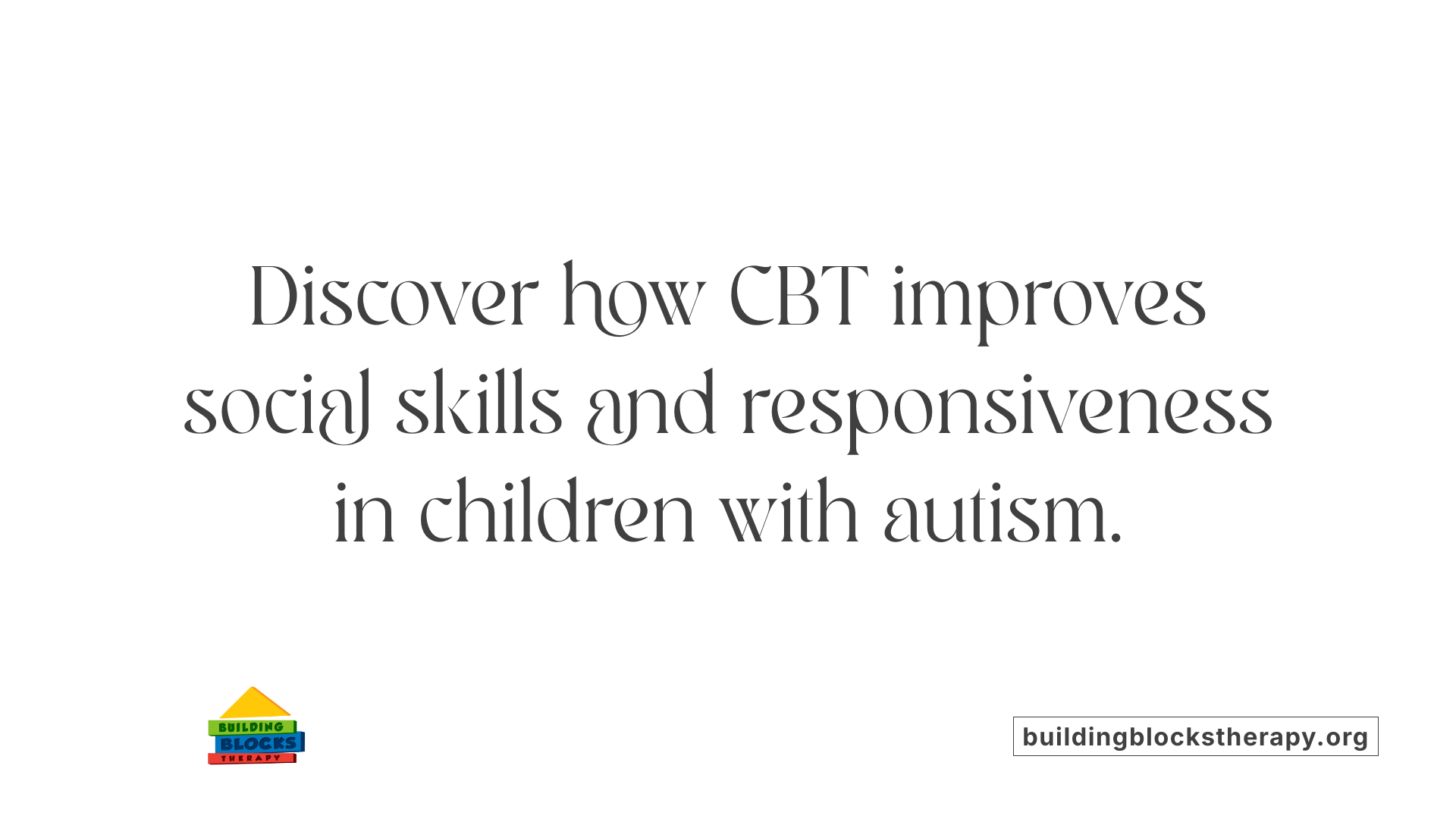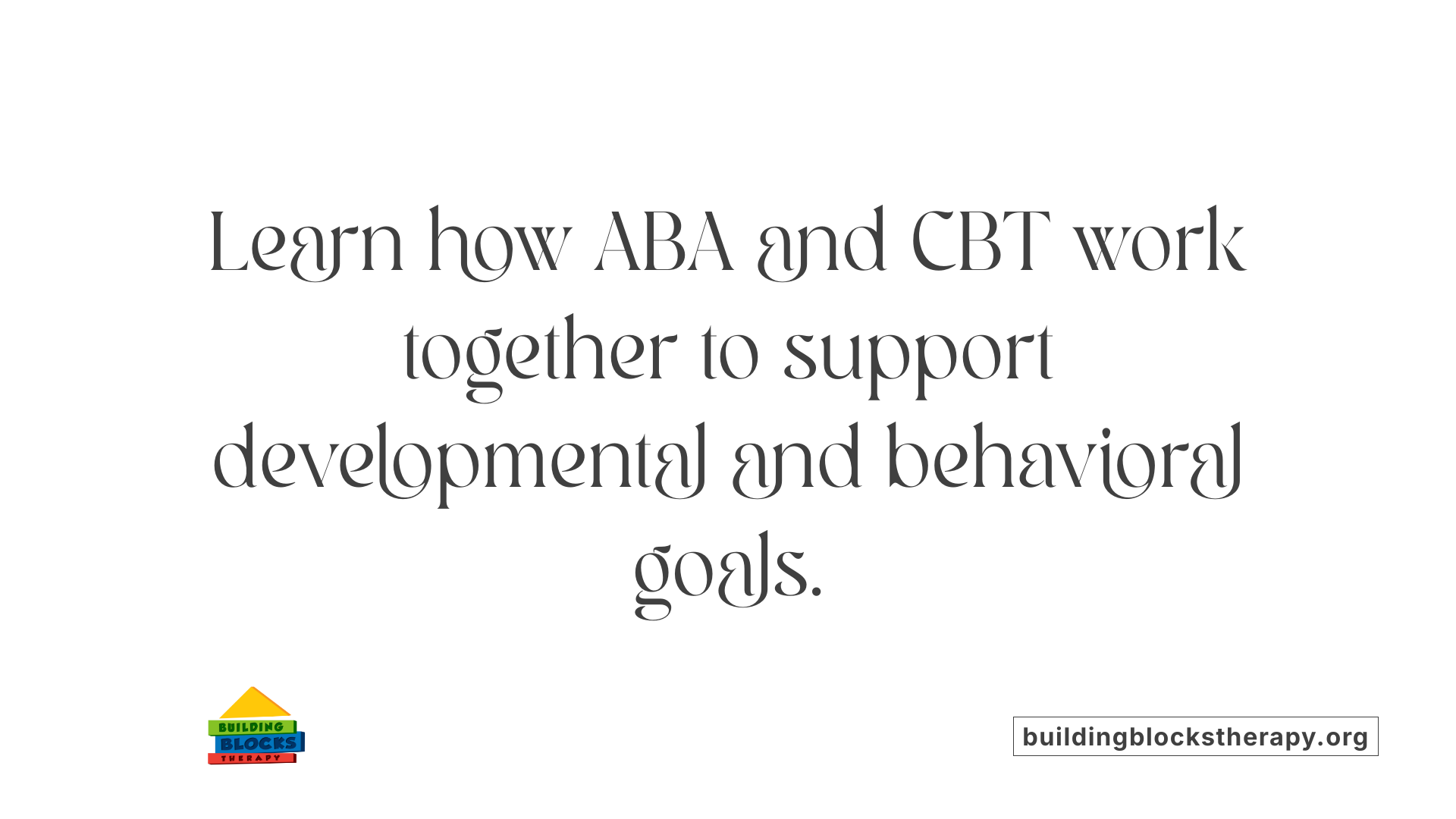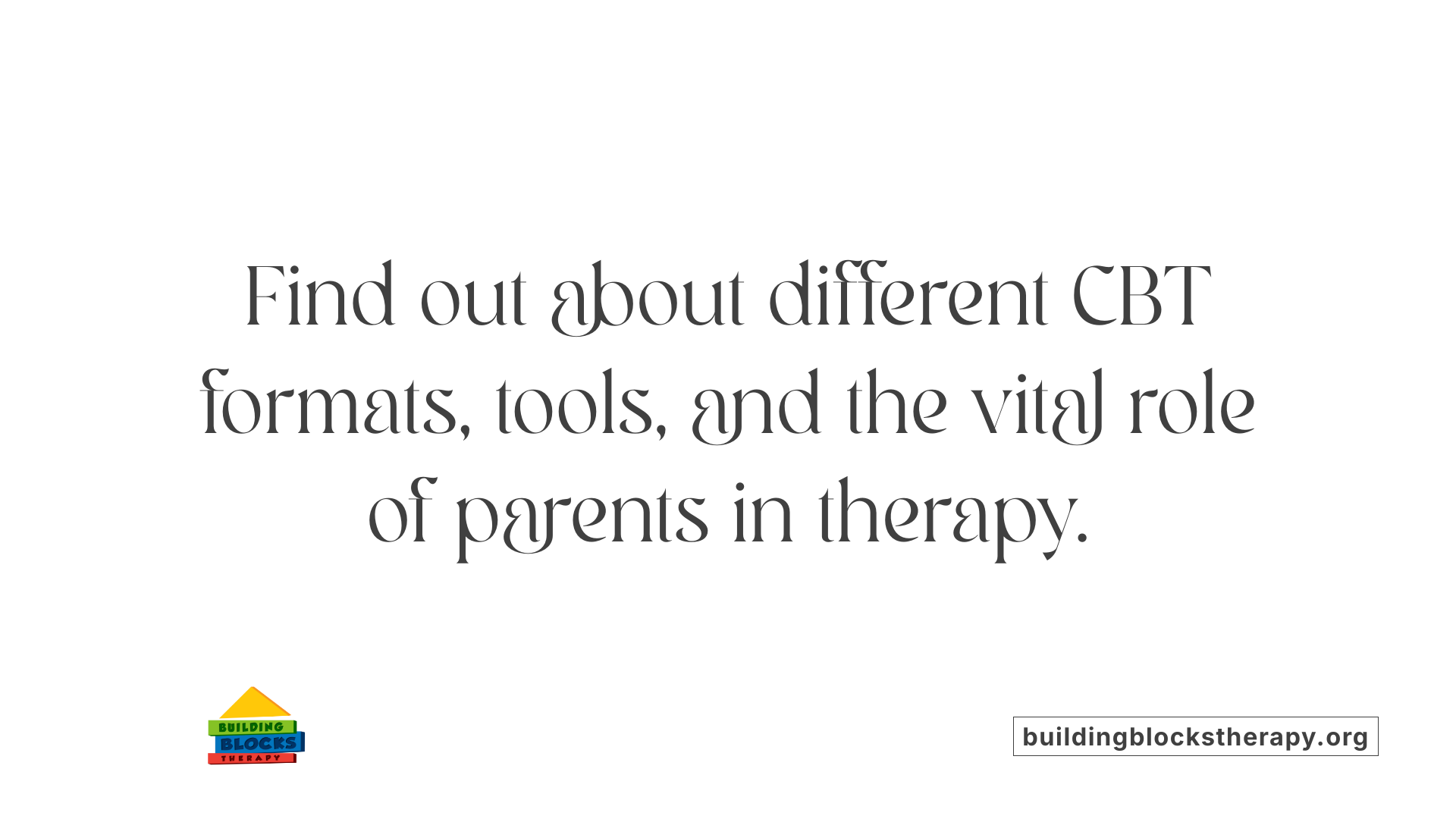Cognitive Behavioral Therapy in Autism
Innovations and Adaptations in Cognitive Behavioral Therapy for Autism Care

Understanding CBT's Role in Autism Spectrum Disorder
Cognitive Behavioral Therapy (CBT) has emerged as a pivotal psychological intervention for individuals with Autism Spectrum Disorder (ASD), particularly in addressing the challenges posed by comorbid conditions such as anxiety, depression, and obsessive-compulsive disorder (OCD). This article explores CBT’s adaptation for autism, its effectiveness, and how it complements other evidence-based therapies like Applied Behavior Analysis (ABA) to provide comprehensive care tailored to the unique needs of those on the spectrum.
Fundamentals of CBT in Autism: Approach and Adaptations

Basic Principles of CBT
Cognitive Behavioral Therapy (CBT) helps individuals by teaching them to recognize and change distorted thoughts and behaviors that lead to emotional distress or problematic reactions. The therapy focuses on the interconnectedness of thoughts, feelings, and behaviors, equipping individuals with skills to better cope with challenges.
Adaptations Necessary for ASD Populations
For individuals with autism spectrum disorder (ASD), CBT must be modified to address differences in communication, cognitive processing, and learning styles. These adaptations include increased structure, usage of visual aids, clear and concrete examples, repetition, and parental involvement to enhance learning. Such modifications make therapy more accessible and effective for autistic individuals.
Therapy Components Focused on Thoughts, Feelings, and Behaviors
CBT sessions guide clients to understand how their thoughts influence feelings and behaviors. Therapists use strategies to challenge and test the validity of automatic thoughts, fostering cognitive restructuring. Behavioral components focus on altering reactions and encouraging positive behaviors while reducing avoidance or maladaptive responses.
Role of Psychoeducation
Psychoeducation is integral to CBT, providing clients and their families with knowledge about ASD and comorbid conditions. This understanding increases motivation, helps identify early warning signs of distress, and supports active engagement in therapy.
Typical Structure and Duration of CBT Programs in Autism Treatment
CBT for autism is usually structured, goal-oriented, and time-limited, often delivered over 12 to 16 sessions. Therapies may be conducted individually, with families, or in groups to target specific needs and build skills effectively.
Addressing Comorbidities: CBT’s Role in Managing Anxiety, Depression, and OCD in ASD

Prevalence of Psychiatric Comorbidities in Autism
Individuals with autism spectrum disorder (ASD) face a high prevalence of psychiatric comorbidities, with 72% to 80% meeting criteria for additional conditions such as anxiety, depression, and obsessive-compulsive disorder (OCD). Anxiety rates among autistic youth vary widely from 11% to 84%, highlighting the breadth of these challenges.
Efficacy of CBT for Anxiety and Depression in Autistic Children and Adults
Cognitive behavioral therapy (CBT) has been shown to effectively reduce anxiety in autistic children and depressive symptoms in adults with ASD. Effect sizes for anxiety reduction in children are generally small to moderate (g = -0.70), while depression in adults sees a moderate benefit (g = -0.39). CBT works by teaching individuals to change maladaptive thoughts and behaviors, helping manage emotional distress and improve social and problem-solving skills.
CBT and OCD Symptom Management
OCD co-occurs in about 37% of the ASD population. Standard CBT incorporating exposure and response prevention (ERP) is the evidence-based treatment for OCD in the general population. For individuals with ASD, adaptations like increased structure, visual aids, and parental involvement improve effectiveness. While CBT shows promise in reducing OCD symptoms in autistic individuals, findings remain less definitive compared to its use for anxiety and depression.
Comparisons Between Standard and Adapted CBT
Studies involving 1,140 participants aged 4-18 years suggest both standard and adapted CBT reduce anxiety symptoms in autistic youth. Adapted CBT—tailored to align with the unique cognitive and learning styles associated with autism—may offer more sustained benefits lasting up to 26 months post-treatment. However, statistical analyses have not conclusively demonstrated a significant difference in efficacy between standard and adapted formats.
Importance of Parental Involvement
Parental involvement is a critical adaptation in delivering CBT to individuals with ASD. Parents often act as coaches, assist with homework, and receive training to help manage OCD and anxiety symptoms outside therapy sessions. This support enhances the generalization of learned coping strategies and contributes to maintaining treatment gains over time.
| Aspect | Details | Additional Notes |
|---|---|---|
| Psychiatric Comorbidities | 72%-80% of individuals with ASD have co-occurring psychiatric disorders | Anxiety 11%-84%; OCD ~37% prevalence |
| CBT Effectiveness | Small to moderate effects for anxiety (children) and depression (adults) | Also shows promise for OCD symptom reduction |
| Adapted CBT Modifications | Increased structure, visual aids, concrete examples, parental involvement | Supports sustained benefits, especially for anxiety |
| Parental Involvement | Parents act as coaches and support generalization of skills | Critical for effective symptom management in ASD |
| Research Limitations | Most participants have IQ > 69; need for studies in lower-functioning populations | Limited conclusive evidence for OCD benefits in ASD |
CBT’s Impact on Core Autism Symptoms: Enhancing Social Skills

Can CBT improve social skills in children with autism?
Yes, cognitive behavioral therapy (CBT) has demonstrated positive effects on social skills in children with autism spectrum disorder (ASD). A meta-analysis involving seven randomized controlled trials with 214 children showed that CBT effectively reduces social impairment. Progress was often measured using the Social Responsiveness Scale (SRS), which highlights this tool’s importance in evaluating social responsiveness and deficits.
Improvements in social responsiveness
CBT not only targets anxiety but also contributes to enhancements in core social symptoms of autism. Children undergoing CBT showed better social interactions and reduced social deficits. This is especially notable given that social skill improvements were often secondary outcomes in the research, reflecting CBT’s broader benefits beyond anxiety relief.
Use of the Social Responsiveness Scale (SRS) to measure progress
Most studies assessing social skills utilized the SRS, a validated scale that measures social behavior in children with ASD. This focus ensures consistent tracking of social responsiveness and helps quantify gains made through therapy.
CBT effects beyond anxiety reduction
While much research on CBT in ASD concentrates on anxiety, evidence suggests it also improves social functioning. This dual effect supports using CBT as a behavioral intervention that holistically addresses emotional and social challenges faced by children with autism.
Need for targeted social skills research
Despite promising findings, many trials have assessed social skills improvement as a secondary outcome, indicating a gap in focused research. More targeted studies are required to determine precisely how CBT enhances social skills and to identify the most effective strategies.
Group therapy and social skills training
Group formats of CBT and complementary social skills training (SST) have been effective for improving social responsiveness. SST, which is often combined with CBT, directly targets social behaviors and has demonstrated additional benefits in reducing anxiety and depressive symptoms in children with ASD.
| Aspect | Detail | Notes |
|---|---|---|
| Social skills improvements | Significant reduction in social impairments shown in meta-analysis of 7 RCTs | Measured primarily by SRS |
| Measurement tool | Social Responsiveness Scale (SRS) | Key for assessing social deficits in ASD |
| CBT benefits | Reduces anxiety and enhances social functioning | Social skill gains often secondary outcome |
| Research gaps | Need for more focused studies on social skills improvement | Current studies treat social outcomes as secondary |
| Group therapy & SST | Effective for social responsiveness and emotional symptom reduction | SST complements CBT interventions |
Integrating CBT with Applied Behavior Analysis (ABA): Complementary Autism Therapies

What is Applied Behavior Analysis (ABA) therapy?
Applied Behavior Analysis (ABA) therapy is a structured, science-based approach that uses principles of learning and reinforcement to teach and improve critical skills in individuals with autism spectrum disorder (ASD). It aims to increase helpful behaviors such as communication, social interaction, and academic skills while reducing harmful or non-productive behaviors. ABA involves customized programs overseen by certified professionals who use specific methods like Discrete Trial Training (DTT), Pivotal Response Treatment (PRT), and the Early Start Denver Model (ESDM). Progress is closely tracked with data collection to adjust goals and interventions as needed.
What are the benefits of ABA therapy for individuals with autism?
ABA therapy is highly effective in supporting people with autism. It fosters meaningful improvements in essential areas such as communication, social skills, and independent living abilities. Early, intensive ABA intervention (often starting between ages 2 and 6) can yield significant developmental advancements. By applying positive reinforcement and personalized strategies, ABA helps individuals learn new skills, reduce problematic behaviors, and better manage daily challenges, enabling a higher quality of life.
Who are the key professionals involved in delivering ABA therapy?
ABA delivery is a team-driven process involving various skilled professionals. Board Certified Behavior Analysts (BCBAs) lead treatment by conducting assessments, setting goals, and supervising therapy plans. Board Certified Assistant Behavior Analysts (BCaBAs) work under BCBA supervision to support these efforts. Registered Behavior Technicians (RBTs) provide direct therapy services, implement interventions, and collect data. Parent and caregiver participation is also crucial, often involving training to reinforce skills and behaviors outside of therapy sessions.
How ABA and CBT complement each other
Whereas ABA focuses on teaching and reinforcing behavioral skills through structured learning and repetition, Cognitive Behavioral Therapy (CBT) targets the thoughts and feelings behind behaviors by addressing emotional regulation and cognitive patterns. Combining ABA's focus on behavior with CBT's emphasis on cognitive and emotional coping techniques offers a comprehensive therapeutic approach. For example, ABA strategies build foundational social and communication skills that CBT can then help individuals apply to manage anxiety, depression, or obsessive-compulsive tendencies common in autism. Both therapies benefit from personalization, parent involvement, and structured formats tailored to the learner's needs.
| Therapy Aspect | ABA Focus | CBT Focus |
|---|---|---|
| Primary Goal | Teaching functional skills and reducing challenging behaviors | Modifying thoughts, feelings, and responses |
| Methods | Discrete trials, reinforcement, naturalistic interventions | Cognitive restructuring, exposure, response prevention |
| Delivery Team | Behavior analysts, technicians, caregivers | Psychologists, therapists, family coaches |
| Target Areas | Communication, social skills, self-care | Anxiety, depression, obsessive behaviors |
| Role of Parents | Training and coaching to reinforce goals | Involvement in homework, behavior management |
| Evidence Base | Strong for developmental and behavioral outcomes | Strong for mental health and emotional regulation |
Delivering CBT: Therapy Formats, Techniques, and Parental Roles

Individual, Group, Family, and Parent Coaching Formats
CBT for individuals with autism spectrum disorder (ASD) is delivered through various formats tailored to the individual's needs. These include individual therapy sessions focusing on personal challenges, group therapy which encourages peer support and social skills development, family sessions that improve collective understanding and dynamics, and parent coaching to empower caregivers in managing behaviors.
Use of Visual Aids and Concrete Examples
To accommodate the learning styles typical in ASD, therapists often use visual aids like anxiety thermometers and clear, concrete examples. These tools help clarify abstract concepts and make the therapy content more accessible and engaging, aiding in comprehension and retention for individuals with ASD.
Incorporation of Sensory Activities and Interests
Integrating sensory activities and focusing on a person's talents and interests are common techniques in modified CBT. These strategies increase engagement and provide a more personalized therapy experience, which can improve motivation and responsiveness to treatment.
Parental Involvement and Coaching
Parental involvement is central in CBT for ASD. Parents often act as coaches, support homework assignments, and receive training to manage OCD or anxiety behaviors effectively. This collaborative approach boosts the therapy's impact by promoting consistency and support in the home environment.
Therapist Roles in CBT for ASD
Therapists specialized in ASD adapt CBT by providing clear instructions, repetitive and concrete teaching, and encouraging self-monitoring. They also tailor communication to the individual's cognitive style and facilitate parental participation, creating a supportive, structured framework that addresses the unique challenges faced by individuals with ASD.
Challenges and Future Directions in CBT for Autism
Research limitations regarding IQ and functioning levels
Many CBT studies for individuals with ASD have primarily included participants with an IQ greater than 69 or 70, focusing on those with high-functioning autism. This limits the ability to generalize findings to lower-functioning populations. There is a clear need for research that explores CBT’s effectiveness and adaptability for individuals across the full spectrum of cognitive functioning.
Need for further targeted studies on social skills and OCD
While CBT has proven effective in reducing anxiety and improving social skills as a secondary outcome, few studies have concentrated specifically on social skill enhancement as the primary goal. Likewise, although CBT adaptations for OCD in ASD show promising symptom reductions, the evidence remains inconclusive, necessitating more focused trials targeting OCD symptoms in this population.
Potential biases and generalization of findings
Many existing studies carry risks of bias and possible publication bias, posing challenges to the robustness of evidence. Additionally, much of the research involves group-based interventions and participants with relatively high cognitive abilities, further restricting broader applicability. Addressing these biases and widening participant diversity will be crucial for future investigations.
Benefits of early intervention across age groups
Early CBT intervention has demonstrated benefits not only for children but extending to adolescents and adults living with ASD. Early therapy can improve quality of life by addressing co-occurring psychiatric conditions such as anxiety and depression, as well as fostering better social and coping skills throughout developmental stages.
Emerging mindfulness and behavioral techniques within CBT
Recent CBT adaptations increasingly incorporate mindfulness-based strategies and behavioral techniques tailored to ASD features. These innovations aim to accommodate sensory and cognitive differences, making therapy more engaging and effective. Such integrative approaches highlight the evolving landscape of CBT tailored for autism, warranting further exploration and validation.
Evolving Perspectives on CBT in Autism Care
Cognitive Behavioral Therapy stands as a vital component in the multidisciplinary approach to autism care, especially for managing co-occurring mental health challenges and enhancing social functioning. Through thoughtful adaptations and integration with complementary therapies like ABA, CBT continues to evolve in effectiveness across ages and cognitive levels. While current research highlights promising results, ongoing studies addressing diverse populations, core autism symptoms, and long-term outcomes will further refine best practices. Ultimately, CBT’s personalized, structured, and collaborative frameworks offer hope and tangible progress for individuals with ASD and their families.
References
- Effectiveness of Cognitive Behavioral Therapy for ...
- Cognitive behavioural therapy to improve social skills in ...
- Cognitive Behavioral Therapy for Autism Spectrum ...
- Treatment and Intervention for Autism Spectrum Disorder
- A cognitive help or hindrance? A systematic review of ...
- Cognitive Behavioral Therapy Efficacious in Autism ...
- Cognitive behaviour therapy for adults with autism ...






